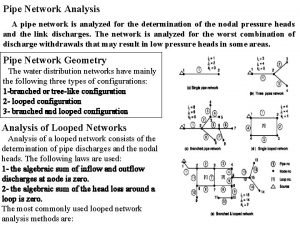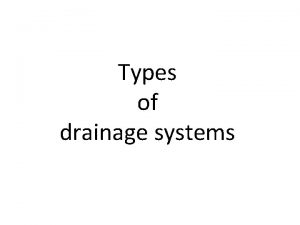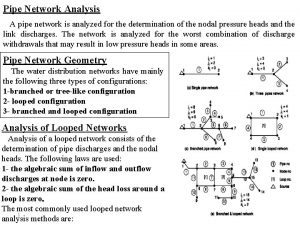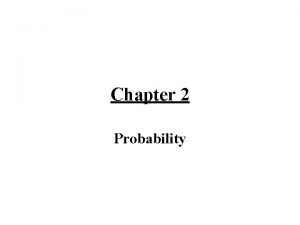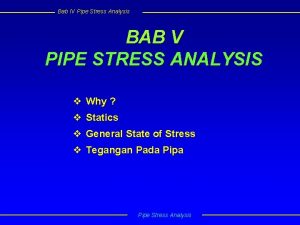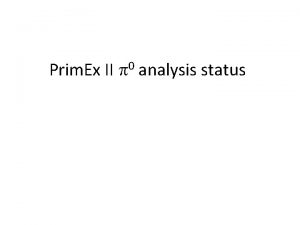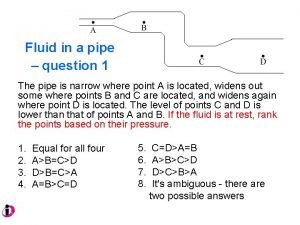Pipe Network Analysis A pipe network is analyzed










- Slides: 10

Pipe Network Analysis A pipe network is analyzed for the determination of the nodal pressure heads and the link discharges. The network is analyzed for the worst combination of discharge withdrawals that may result in low pressure heads in some areas. Pipe Network Geometry The water distribution networks have mainly the following three types of configurations: 1 -branched or tree-like configuration 2 - looped configuration 3 - branched and looped configuration Analysis of Looped Networks Analysis of a looped network consists of the determination of pipe discharges and the nodal heads. The following laws are used: 1 - the algebraic sum of inflow and outflow discharges at node is zero. 2 - the algebraic sum of the head loss around a loop is zero. The most commonly used looped network analysis methods are: 1

1 - Hardy Cross Method The following figure shows a relatively simple network consisting of seven pipes, two reservoirs, and one pump. The hydraulic grade lines at A and F are assumed known; these locations are termed fixed-grade nodes. Outflow demands are present at nodes C and D. Nodes C and D, along with nodes B and E are called interior nodes or junctions. Flow directions, even though not initially known, are assumed to be in the directions shown. 1 -1 - Generalized Network Equations Networks of piping, such as those shown in the figure can be represented by the following equations. 1. Continuity at the jth interior node: in which the subscript j refers to the pipes connected to a node, and Qe is the external. Use the positive sign for flow into the junction, and the negative sign for flow out of the junction. Representative piping network: (a) assumed flow directions and numbering scheme (b) designated interior loops 2 (c) path between two fixed-grade nodes

P = J + L + F – 1 -------(3) In the figure above note that , J = 4, L = 2, F = 2, so that P = 4 + 2 -1 = 7 3

4

5

Example 1: The pipe network of two loops as shown in Fig. 3. 11 has to be analyzed by the Hardy Cross method for pipe flows for given pipe lengths L and pipe diameters D. The nodal inflow at node 1 and nodal outflow at node 3 are shown in the figure. Assume a constant friction factor f = 0. 02. Solution There are four junctions (J = 4), five pipes (P = 5), and (F= 0). Hence the number of closed loops is : L = P - J - F + 1 L = 5 - 4 - 0 + 1 = 2. The two loops and assumed flow directions are as shown. Equation 6 is applied to each loop as follows: To apply continuity equation for initial pipe discharges, the discharges in pipes 1 and 5 equal to 0. 1 m 3/s are assumed. Th e obtained discharges are Q 1 = 0. 1 m 3/s (flow from node 1 to node 2) Q 2 = 0. 1 m 3/s (flow from node 2 to node 3) Q 3 = 0. 4 m 3/s (flow from node 4 to node 3) Q 4 = 0. 4 m 3/s (flow from node 1 to node 4) Q 5 = 0. 1 m 3/s (flow from node 1 to node 3) 6

7

8

9

10
 Pipe network analysis example
Pipe network analysis example Double pipe heat exchanger design calculation
Double pipe heat exchanger design calculation Single pipe system
Single pipe system Pipe network analysis
Pipe network analysis Features of system analysis
Features of system analysis Indentation
Indentation Time domain analysis of control system
Time domain analysis of control system What conclusion can you draw out form the pie graph
What conclusion can you draw out form the pie graph Explain why a community problem have to be analyzed
Explain why a community problem have to be analyzed An item with zero discriminating power must be retained.
An item with zero discriminating power must be retained. Disks of polycarbonate plastic from a supplier are analyzed
Disks of polycarbonate plastic from a supplier are analyzed
